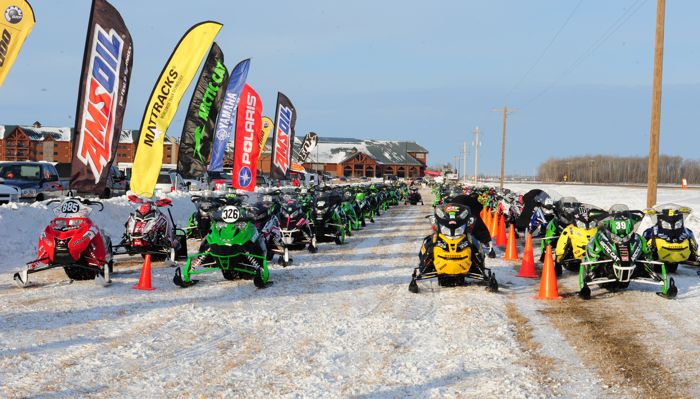
In the absence of the USXC I-500 this year due to snow, last weekend’s two-day Seven Clans Casino/Thief River Falls 300 gave us the challenge and drama of long distance cross-country racing.
There were 140-something racers at the TRF 300, each of whom was treated with decent-to-good snow conditions. Most of the classes ran two 65-mile loops each day, with a fuel stop between each of the loops.
If the TRF 300 was any indication of what the I-500 might have been, USXC did a great job and Team Arctic would have been very, very impressive.
As it was, the men, women, boys and girls in green took home 17 class wins (out of 21) and 40 podium positions.
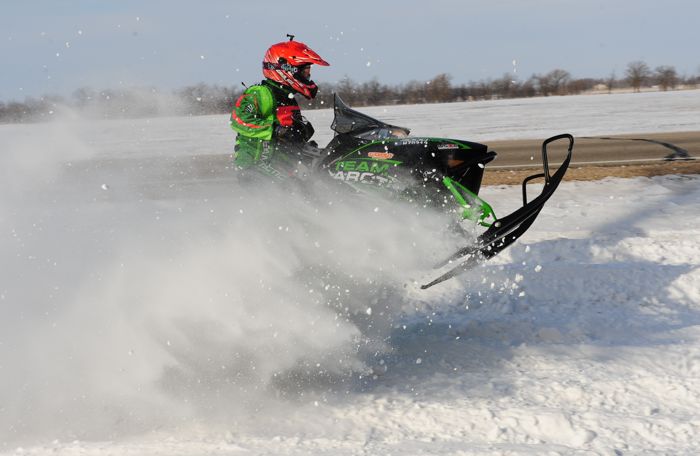
One of those wins came at the hands of Savannah Landrus, who showed no fear in her pursuit of victory in the Girls 14-17 class.

James Mattison raced his Zed Argh to a win in the Classic IFS Legends Over 50 One-Handed class. I have no idea what it’s like to race for 65 miles using just my right hand, but it must have been thrilling.

Mike Mattison is another of the Mattison Racing crew that consists of 83 drivers, 47 mechanics and 395 rabid fans. Mike hauled home his own first place hardware in the Vintage class.

The grizzled statesman of the Mattison team, Gerry Mattison showed his speed and savvy to win the Vintage Legends class ahead of brother Pete.
I didn’t get a photo of Karl Mattison, which is unfortunate because he won the Classic IFS 1980-1997 class.
Just know this: Mattison Racing Wins!
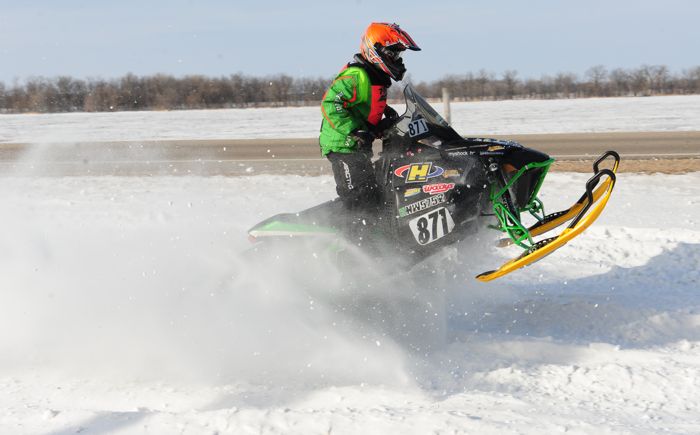
David Brown was on the gas and blasting ditch approaches on his way to winning the Jr. 10-13 class.
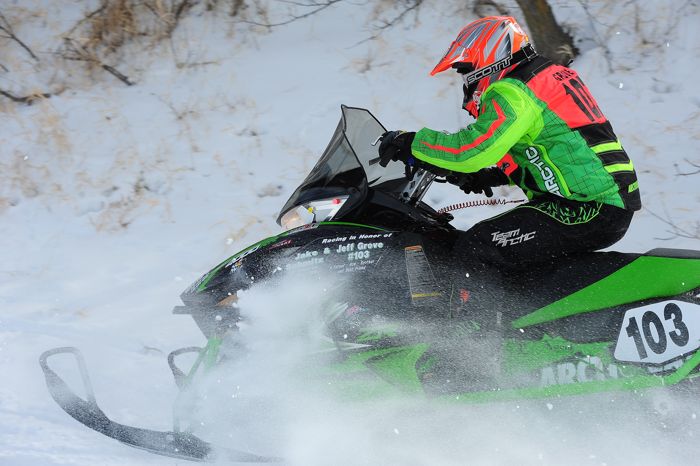
Jeremy Grove took two class wins in TRF: Expert 85 and Expert 85 Improved.

Ean Voigt won Trail, keeping his winning streak alive (I’m pretty sure he’s won at least one class at every event this season).
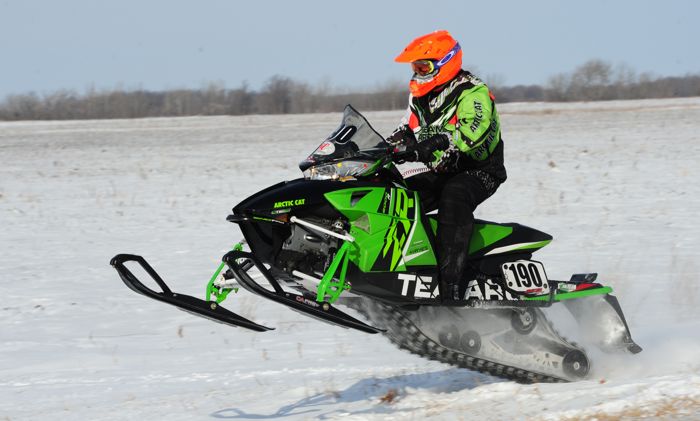
Proving he’s as fast in the ditch as he is on the lake, Jon Arneson motored to victory in the Masters 40 and Over class.

Brandon Wolter is at his best in the rough stuff, and he proved it with a win in Sport 85 and a second in Expert 85.

Timmy Kallock is another racer who shines brightest in the ditch. He won Semi Pro Improved, took fourth in Pro Stock and would have won Semi Pro Stock had he entered it. Oops!

I’m not sure if we’ll ever see another woman racer who can win rugged cross-country races with the regularity and career span of Jolene Bute. She was on her A-game in TRF, taking the win in convincing fashion.

The Pro Stock class served up a dramatic duel between Team Arctic’s Zach Herfindahl and Wes Selby.
After Saturday’s 130 miles, Selby had a 1-minute, 0.8-second lead over Herfindahl. USXC allows racers to choose whether or not to take a 1-hour maintenance session. If they do take it, one minute is added to their time.
After seeing a few Cat racers suffer from broken drive clutch springs during the day, Selby opted to take the session and replace his as precaution, while Herfindahl gambled by opting out of the session. That put Herfindahl less than one second behind Selby for the start of the second day’s two 65-mile loops.
During the first loop, Selby stretched his lead to around seven seconds. A slight bobble in the fuel stop closed the gap slightly, but he left the fuel area with around 5 seconds over his teammate.
Five or so miles into the second loop, Selby’s clutch spring broke, dropping his acceleration and speed enough that Herfindahl caught him.
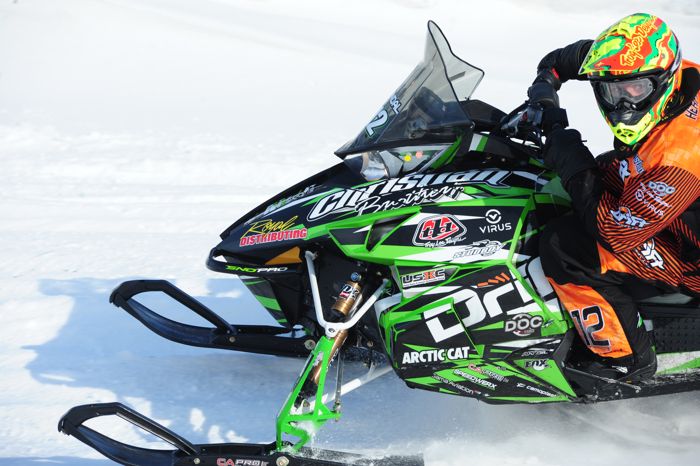
Here at the 40-mile mark of the second loop, Herfindahl hit the river and looked back to see where Selby was.
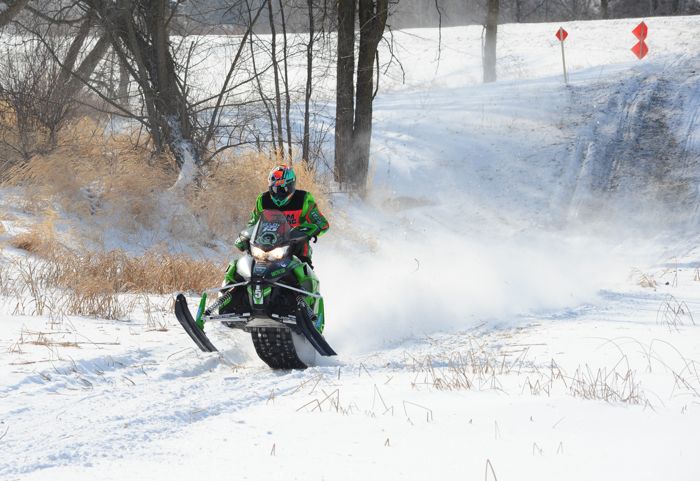
What he saw was a man on mission, just a handful of seconds behind and barreling down on him.
It appeared that an already epic battle would be decided with a 25-mile drag race to the finish, but a siezed engine ended Herfindahl’s day just 15 miles to the finish.
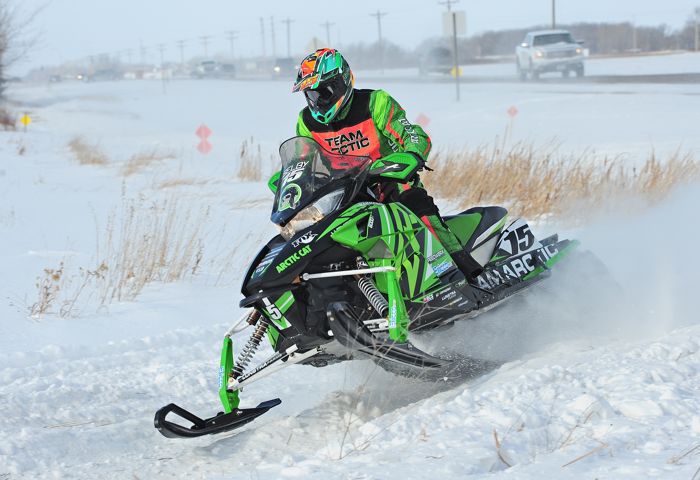
And with that, Selby cruised into the finish with a nearly 10-minute lead over second place.

Taking second was Yamaha’s Matt Piche. It was the second USXC cross-country in a row that Yamaha took second in the premier class, and it shows the blue team has made the jump to contending for wins.

Cody Kallock made up three minutes on Piche during day two, but came up five seconds short of catching him before the finish. Kallock rode an awesome race!
In all, Team Arctic scored six of the top-10 places in Pro Stock. Pretty darn impressive.

Wes Selby (left) was greeted at the finish by Dawn Haugen of the Team Arctic Race Department, while Race Manager Mike Kloety (right) streamed the farm report from KTRF radio on his smartphone.
The TRF 300 win marks Selby’s third major victory in a month, and suggests he’s on something of a roll as we head to the final race of the USXC season beginning tomorrow in Warroad, Minn.
Congrats to all the racers who competed in TRF. And an apology to Matt Feil, who was the other Team Arctic class winner (Sport 600 Open) whose photo I failed to capture. Matt is on the ArcticInsider factory team, so that makes me double-lame.
Thanks for reading.



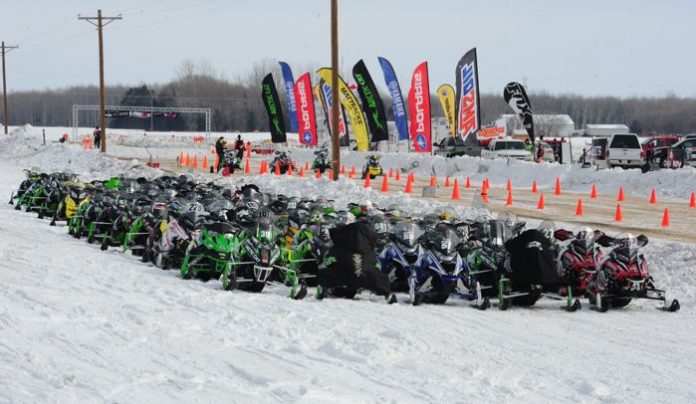
Yawn… Sure does get boring reading about Cat dominating cross county yewe after year… Actually no, no it doesn’t…
The picture of Herfindahl staring at you is pretty great John..
I would like to know what seized on Zach’s sled. The 600 seems to be a pretty bulletproof motor! Very surprised to read that.
Congrats Team Arctic! My hats off to those vintage guys! I can feel my back hurting just looking at those pictures.
Ditto on finding out about that seized motor. Also curious about the drive springs that kept breaking. What a kick in the nuggets to replace it and have it break anyways.
Wow! Great result. I see yamaha’s in 2 and 8 also meaning 8 out of top the 10, and all top 6 are procross sleds! And on the prior posts some of you are mad that there is not more new tech like the Axis that managed 7 and 9th… Procross chassis is handling pretty well in the bumps with both the 2 and 4-stroke versions.
And as for motors I own one a 2015 6000 eltigre. I went on a 415 mile ride Thursday this week along with a 2012 800 procross. We tracked fuel and oil consumption to see how they compare. You can never compare unless you ride same trail, same speed, same day, so please those of you who are thinking “mine does better or worse than that” forget about it. Mileage changes up or down depending on the ride. But in this case, 2 guys, same riding style, traveling same pace together, both prior cross country racers, on a fast trail pace, but not race pace. My 600 used 31.25 gallons of fuel. The 800 used 30.75. 1/2 gallon total less than my 600 for averages of 13.5/13.3 respectively. On oil, my 600 used 1.8 qts and the 800 used 3.4 qts.
So I did some math. I figure gas at 2.80 per gallon, the 800 was 1.40 cheaper to run 415 miles. Ctec2 oil for my 600 at $50 per gallon I used $22.5 in oil. APV in the 800 at $40 per gallon used $34 in oil. So the 800 cost $11.5 more in oil, but used 1.40 less in fuel. Total cost of operation difference in 415 miles $10.10. Figure a 2000 mile season and were at $50.50 difference.
I was impressed with the 800’s mileage and am not surprised cat would sit on that another year. I don’t think it is as old and stinky as the competition would like you to believe since the mileage is better, on this ride anyway, than cat’s own 600…
Makes you think how great it would have been to have had the I-500 this year. Kudos to all the work the usxc did before it had to be cancelled.
Too bad, would have been quite a show. Hope things work out for next year.
Phil…
Without going into great detail… over the 1100-1500 miles I have ridden this year on my 13 800 RR 90% have been with my father on his 15 600 RR (I am sure his is well above 1500, maybe 1800 total miles). We have experienced literally complete opposite results; similar only to your quoted oil consumption. My 800 is a binge drinker compared to the ‘Convent Sister’ communion only drinker C-Tec. Taking nothing away form the HO (I have had two) which have been literally bullet proof for me, from my experience, the C-tec is in a class of its own. I look forward to where this platform will take Cat in the future…
I am curious as to why some riders opt for the Podium RC2s vs the Evol RC2s. In my own mind I assumed the coil over offered a more linear absorption… this why they were used for the lake courses. However, seeing the 15 with Podiums (from what I can see) in the ditch leaves me scratching my head again.
Ryan, not so sure I agree with c-tec being in class of their own. Great sleds, great engine, still uses more oil and fuel than I thought it would when riden harder.I know I’ll be crucified for saying so but I guess I expected too much .
Ryan,
Thanks for the input. I am definitely the first to say conditions and styles are a huge factor and results vary. Do you see the Ctec vs 800 mileage sway more toward the 800 when you are pushing them hard and more toward the 600 when under lighter paces? That’s pretty much what we see. Are your typical averages close to what we had?
Dont take that information wrong, I love the Ctec. It’s 3 MPG better, in about every condition, than the sled it replaced, while using 1/2 the oil. If not better, at least close, to every other 600 out there, while having a less expensive and very durable design. A US build 800 version would be cool and the future is bright. I’m just saying I sure am not dissabointed with the 800 either, and am actually suprised it was, on fuel, better than mine in our riding style/conditions. Only decision left is which motor size I choose next time.
Alot of the guys are going with the podiums over the Evols to prevent leak downs and a change in the air spring rate if a seal were to fail or just because sometimes they dont hold air.
I went to the stage 5 Elka’s on my sleds and will never go back to Evols.
Phil,
We can compare and contrast styles of riding all day with each keyboard racer with cross country racing, oval racing, water cross racing, and hillcross racing styles of riding alike – pointless. The term “pushed” is a relative term not measurable by my means atleast. With this said I don’t know why they even put throttles on snowmobiles as I prefer to ride wide open from the time the rope is pulled to the first stop for a Monster and a snickers (not really). *I type this with the most sarcasm I can add into a post*. I try to stay away from trying to describe riding styles with anyone. Trust me, I am blistering fast when I am by myself racing around lake barrels – then you ride Mr. Arctic Insider and you get a reality check, and the flu.
I keep a running spreadsheet through out the year on my two main sleds I ride (800 HO, 440 ZR – see Ride wit the Champs article). Beginning with my 04 F6 I have found this to me by most valuable tool when I look back on years past; also I can avoid costly changes to the machine that take me steps backwards with data collected at the end of each ride and with notes of changes made. For example, I dont know how I could have got to the point I am at now with my 800 or 440 using STM weights without the spreadsheet – simply too much to remember. If you watch the data further out the deviation between the 800 and the 600 the results really appear evident. I think you have a good start with what you posted to construction on your own spreadsheet. I would like to see the data set between the 6000 and 7000 machines.
yamahabandit,
We will respectfully disagree. However, my expectations of LED lights to match my GMC were not met for next year. Darn!
alex,
Thank you.
Congrats to Team Arctic ! Especially the Mattison racing gang. Truly a great group of guys!! I’d love to see a story on them and their collection of racing Cats.
There are very few things in life that are more fun than a XC snowmobile race out of TRF…old school. If you think you are good, this is the place to find out!
Tell Mike Kloety he can just call 218-964-5249 for the price of rice in China.
I remember back in the day were u can take your 440cc trail sled and race it and then trail ride the next day. Next thing I know, the XC race sleds got to specialized and expensive for the consumer to buy and only available to pro and semi pro riders.
Now they have gone back to the way it should be, by producing XC race sleds with a stock production engine (600cc) that basically we can all purchase. The onlt thing that really changed was beefier suspension and chassis and related components.
XC racing should be left for production built sleds, that’s how XC racing was meant to be and started from.
Agreed 110% Derek. I remember even going to pro sno X races and ice oval races and seeing guys with tilt back trailers racing in the top classes and running well. This is how sled racing should be.